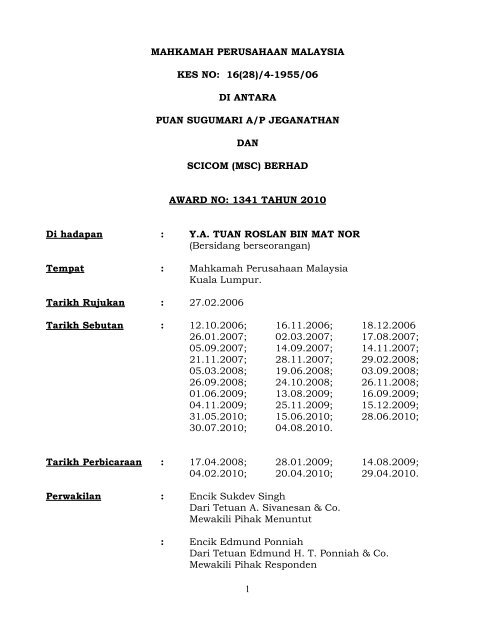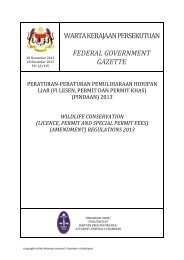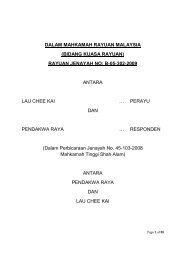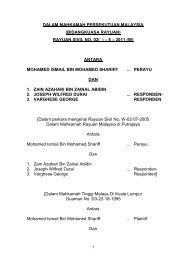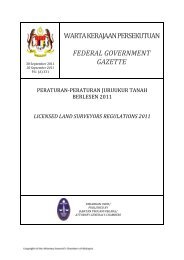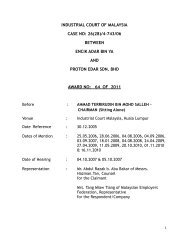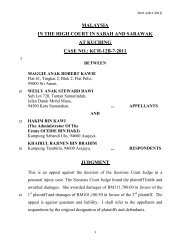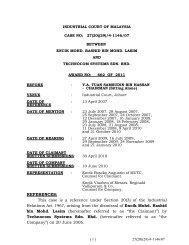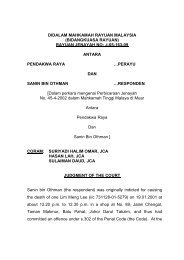MAHKAMAH PERUSAHAAN MALAYSIA KES NO: 16(28)/4-1955/06 ...
MAHKAMAH PERUSAHAAN MALAYSIA KES NO: 16(28)/4-1955/06 ...
MAHKAMAH PERUSAHAAN MALAYSIA KES NO: 16(28)/4-1955/06 ...
You also want an ePaper? Increase the reach of your titles
YUMPU automatically turns print PDFs into web optimized ePapers that Google loves.
<strong>MAHKAMAH</strong> <strong>PERUSAHAAN</strong> <strong>MALAYSIA</strong><br />
<strong>KES</strong> <strong>NO</strong>: <strong>16</strong>(<strong>28</strong>)/4-<strong>1955</strong>/<strong>06</strong><br />
DI ANTARA<br />
PUAN SUGUMARI A/P JEGANATHAN<br />
DAN<br />
SCICOM (MSC) BERHAD<br />
AWARD <strong>NO</strong>: 1341 TAHUN 2010<br />
Di hadapan : Y.A. TUAN ROSLAN BIN MAT <strong>NO</strong>R<br />
(Bersidang berseorangan)<br />
Tempat : Mahkamah Perusahaan Malaysia<br />
Kuala Lumpur.<br />
Tarikh Rujukan : 27.02.20<strong>06</strong><br />
Tarikh Sebutan : 12.10.20<strong>06</strong>; <strong>16</strong>.11.20<strong>06</strong>; 18.12.20<strong>06</strong><br />
26.01.2007; 02.03.2007; 17.08.2007;<br />
05.09.2007; 14.09.2007; 14.11.2007;<br />
21.11.2007; <strong>28</strong>.11.2007; 29.02.2008;<br />
05.03.2008; 19.<strong>06</strong>.2008; 03.09.2008;<br />
26.09.2008; 24.10.2008; 26.11.2008;<br />
01.<strong>06</strong>.2009; 13.08.2009; <strong>16</strong>.09.2009;<br />
04.11.2009; 25.11.2009; 15.12.2009;<br />
31.05.2010; 15.<strong>06</strong>.2010; <strong>28</strong>.<strong>06</strong>.2010;<br />
30.07.2010; 04.08.2010.<br />
Tarikh Perbicaraan : 17.04.2008; <strong>28</strong>.01.2009; 14.08.2009;<br />
04.02.2010; 20.04.2010; 29.04.2010.<br />
Perwakilan<br />
: Encik Sukdev Singh<br />
Dari Tetuan A. Sivanesan & Co.<br />
Mewakili Pihak Menuntut<br />
: Encik Edmund Ponniah<br />
Dari Tetuan Edmund H. T. Ponniah & Co.<br />
Mewakili Pihak Responden<br />
1
Rujukan :<br />
Ini adalah suatu rujukan yang dibuat di bawah Seksyen 20(3), Akta<br />
Perhubungan Perusahaan 1967 yang timbul dari pembuangan kerja Puan<br />
Sugumari A/P Jeganathan (selepas ini disebut sebagai Pihak Menuntut) oleh<br />
SCICOM (MSC) Berhad (selepas ini disebut sebagai Pihak Responden) pada<br />
17.11.2004. Kes ini telah dirujuk oleh Y. B. Menteri Sumber Manusia pada<br />
27.02.20<strong>06</strong> dan diterima oleh Mahkamah Perusahaan ini pada 07.09.20<strong>06</strong>.<br />
Latar Belakang<br />
AWARD<br />
1. Kes ini telah didengar oleh Pengerusi Mahkamah Perusahaan yang telah<br />
bertukar pada 1hb April 2009. Pengerusi tersebut telah mendengar keterangan<br />
COW1 dan sebahagian keterangan CLW1 sebelum ditukarkan.<br />
2. Pada 14hb Ogos 2009 kes ini telah dibicarakan di hadapan saya. Kedua-dua<br />
pihak tidak menzahirkan bantahan mereka untuk kes ini diteruskan di hadapan<br />
saya dari peringkat di mana kes didengar oleh Pengerusi yang telah ditukarkan<br />
pada <strong>28</strong>hb Januari 2009. Pihak Menuntut telah bersetuju untuk memberikan<br />
keterangan walaupun COW1 belum tamat memberikan keterangan disebabkan<br />
COW1 tidak dapat hadir kerana sedang berada di luar negara. Pengerusi yang<br />
terdahulu telah membenarkan Pihak Menuntut memberikan keterangan beliau.<br />
2
3. Pada 4hb Februari 2010, saksi kedua memberikan keterangan. Seterusnya<br />
saksi ketiga Responden memberikan keterangan pada 29hb April 2010 setelah<br />
Pihak Menuntut selesai memberikan keterangannya.<br />
4. Dalam konteks ini, Mahkamah perlu melihat sama ada proses pemberian<br />
keterangan oleh Pihak Menuntut ketika saksi Pihak Responden masih belum selesai<br />
memberikan keterangan dan Pihak Responden masih belum menutup kes mereka,<br />
tidak menjejaskan perbicaraan kes ini. Adalah tidak dapat dinafikan pada<br />
lazimnya, Pihak Menuntut akan hanya memulakan keterangan setelah Pihak<br />
Responden menutup kes mereka. Jika diteliti Peraturan 22 Kaedah-kaedah<br />
Mahkamah Perusahaan 1967 telah memperuntukkan seperti berikut:<br />
22. Procedure at Hearing<br />
(1) At the hearing, the President shall call upon such party as he<br />
may think fit to state his case and adduce evidence, if any, in<br />
support thereof.<br />
(2) ….........................<br />
(3) …..........................<br />
(4) …..........................<br />
5. Jika diteliti sepintas lalu, Peraturan 22 itu menunjukkan bahawa Pengerusi<br />
mempunyai budi bicara untuk memanggil mana-mana pihak untuk mengemukakan<br />
keterangan. Tiada peruntukan bertulis di dalam Peraturan-Peraturan Mahkamah<br />
3
Perusahaan 1967 yang menghendaki Pihak Menuntut dan Pihak Responden<br />
memulakan kes mereka. Namun demikian adalah menjadi amalan yang diterima<br />
oleh Mahkamah Perusahaan di dalam kes yang melibatkan pembuangan kerja<br />
biasa, Pihak Responden akan memulakan kes mereka. Sementara itu bagi kes yang<br />
melibatkan pembuangan kerja konstruktif, Pihak Menuntut yang akan memulakan<br />
kes.<br />
6. Secara perbandingan jika diteliti peruntukan di bawah Kaedah-Kaedah<br />
Mahkamah 1980 mengenai susunan pihak yang perlu memulakan perbicaraan<br />
adalah seperti di bawah Kaedah 35 Aturan 4 (035R4) yang menyatakan:<br />
Rule 4. Order of speeches. (O.35 r.4)<br />
(1) The Judge before whom an action is tried may give directions as to the<br />
party to begin and the order of speeches at the trial, and, subject to any<br />
such directions, the party to begin and the order of speeches shall be<br />
that provided by this rule.<br />
(2) Subject to paragraph (6), the plaintiff shall begin by opening his case.<br />
(3) If the defendant elects not to adduce evidence, then, whether or not the<br />
defendant has in the course of cross-examination of a witness for the<br />
plaintiff or otherwise put in a document, the plaintiff may, after the<br />
evidence on his behalf has been given, wake a second speech closing his<br />
4
case and the defendant shall then state his case.<br />
(4) If the defendant elects to adduce evidence, he may, after any evidence<br />
on behalf of the plaintiff has been given, open his case and, after the<br />
evidence on his behalf has been given, make a second speech closing<br />
his case, and at the close of the defendant's case the plaintiff may<br />
make a speech in reply.<br />
(5) …........................<br />
(6) ….......................<br />
(7) …........................<br />
7. Di dalam kes ini Pihak Menuntut telah memberikan keterangan selepas<br />
COW1 memberikan keterangan setelah menyatakan kes ini adalah melibatkan<br />
pembuangan kerja konstruktif. Pada <strong>28</strong>hb Januari 2009 terdapat catatan nota<br />
keterangan seperti berikut:<br />
“- Peguam Menuntut setuju untuk Yang Menuntut memberi keterangan<br />
kerana COW1 masih tidak hadir. Peguam Responden berpendapat<br />
COW1 masih berada di luar negeri.<br />
5
- Memandangkan kes ini adalah constructive dismissal maka Mahkamah<br />
tidak ada masalah untuk Yang Menuntut memberikan keterangan<br />
tersebut dahulu.”<br />
8. Berdasarkan kepada Peraturan 22 Peraturan-Peraturan Mahkamah<br />
Perusahaan 1967, Mahkamah berpendapat tiada peruntukan tetap mengenai<br />
siapakah yang memulakan kes tetapi adalah bergantung kepada budi bicara<br />
Pengerusi. Namun demikian, Mahkamah di dalam menimbangkan siapakah yang<br />
memulakan kes hendaklah mengambil kira perkara-perkara berikut:<br />
(a) Jenis pembuangan kerja sama ada pembuangan kerja biasa;<br />
pembuangan kerja konstruktif atau pengurangan tenaga kerja<br />
(retrenchment).<br />
(b) Adakah dengan membenarkan sesuatu pihak memulakan kes itu<br />
ia akan menjejaskan tugasnya untuk membuktikan kesnya.<br />
(c) Jika sesuatu pihak dibenarkan untuk memulakan sesuatu kes yang<br />
pada awalnya dimulakan oleh sesuatu pihak, Mahkamah harus<br />
melihat sama ada ia akan memprejudiskan pihak yang sepatutnya<br />
memulakan kes tersebut. Misalnya, di dalam kes pembuangan kerja<br />
biasa, Pihak Responden akan terlebih dahulu memberikan keterangan,<br />
jika Pihak Menuntut diberi peluang untuk memulakan kes, ia<br />
6
seharusnya tidak memprejudiskan Pihak Responden. Jika terdapat<br />
sebarang keterangan yang memerlukan penjelasan lanjut oleh Pihak<br />
Responden, Mahkamah akan memberi peluang untuk Pihak<br />
Responden memberikan penjelasan dalam memanggil saksi yang<br />
selanjutnya.<br />
9. Di dalam kes ini Mahkamah berpendapat keterangan yang terlebih dahulu<br />
diberikan oleh Pihak Responden tidak menimbulkan prejudis kepada kes Pihak<br />
Menuntut. Ia juga tidak menjejaskan perbicaraan adil kes ini. Ini ditambah pula<br />
kedua-dua pihak tidak membantahnya.<br />
Fakta Kes<br />
10. Pihak Menuntut telah mulai bekerja di syarikat Responden sebagai Customer<br />
Service Professional mulai 15hb September 1997 dan ditawarkan jawatan tetap<br />
sebagai Telesales Professional mulai 1hb September 1998.<br />
11. Pada 26hb Oktober 2004, Pihak Menuntut telah menerima satu surat amaran<br />
daripada syarikat seperti berikut:<br />
SCICOM<br />
26/10/2004<br />
Sugumari a/p Jeganathan<br />
Senior Operations Manager<br />
Celcom Project<br />
7
Dear Sugumari<br />
Re: Warning Letter – Prompt Action against Major Misconduct<br />
This is with reference to our show cause letter dated 20/09/2004 and your<br />
response dated 24/09/2004.<br />
The management has reviewed your response and while it is accepted that<br />
your line manager was aware of your decision to allow the employee access to<br />
the systems, it does not absolve you of making an erroneous decision that<br />
exposed the Company to risk of further fraud and potential financial loses.<br />
As a Senior Manager of the Company it is expected that you carry out your<br />
duties diligently at all times. It is also expected that when aware of any<br />
such instances someone in your position should ensure that all possible<br />
action is taken to mitigate any further risk to the Company. In this instance<br />
you have failed to perform your duties as would be expected of a Senior<br />
Manager by allowing the employee access to the system inspite of being aware<br />
of the employee's alleged involvement in the fraudulent activity.<br />
As a consequence of this act, you are hereby advised that you will not receive<br />
any performance related bonus for the second half of the year 2004 (July to<br />
December). You are also warned that any further failure to perform your<br />
duties will result in disciplinary proceeding that may result in severe action<br />
being taken against you.<br />
Kindly acknowledge receipt of this letter by signing on the duplicate copy<br />
and returning the same to us.<br />
Yours faithfully,<br />
For Scicom (MSC) Sdn Bhd<br />
sgn.<br />
Benny Philip<br />
VICE PRESIDENT PROJECTS AND PLANNING<br />
cc: Vice President – Operations (Celcom Project)<br />
12. Pihak Menuntut seterusnya menerima surat amaran daripada Pihak<br />
Responden bertarikh 8hb November 2004 yang keterangan seperti berikut:<br />
8
SCICOM<br />
08/11/2004<br />
Sugumari a/p Jeganathan<br />
Senior Operations Manager<br />
Celcom Project<br />
Dear Sugumari<br />
Re:<br />
Warning Letter – Prompt Action against Major Misconduct<br />
This with reference to your letter dated 01/11/2004 and the discussion that<br />
you had with Akid William Tosh and me on 04/11/2004.<br />
As was explained to you at that meeting, the warning letter issued to you was<br />
with reference to your decision to allow an employee, who was allegedly<br />
involved in committing fraud, access to the Company's systems, inspite of<br />
being aware of his alleged involvement.<br />
By doing so you have given the employee an opportunity to commit further<br />
fraudulent transactions and have thereby exposed the Company to the risk of<br />
further losses both financial and reputational.<br />
This is a serious lapse in judgement which could have impacted the Company<br />
severely.<br />
While your explanation dated 24/09/2004 clarifies the fact that your line<br />
manager was aware of the fraud, it does not justify your action of allowing the<br />
employee access to the systems. Further more we would like to remind you<br />
that as Senior Manager Operations, you are expected to exercise sound<br />
judgement and make decisions where necessary to ensure that the interest of<br />
the Company is always protected. In this instance you have failed to do so<br />
and therefore we regret to inform you that the warning letter will not be<br />
withdrawn.<br />
Kindly acknowledge receipt of this letter by signing on the duplicate copy and<br />
returning the same to us.<br />
Yours faithfully,<br />
For Scicom (MSC) Sdn. Bhd.<br />
sgn.<br />
Benny Philip<br />
9
VICE PRESIDENT PROJECTS AND PLANNING<br />
cc: Vice President – Operations (Celcom Project)<br />
Ekoran daripada surat amaran tersebut Pihak Menuntut telah mengambil<br />
keputusan untuk meninggalkan syarikat tersebut mulai 17.11.2004 melalui surat<br />
bertarikh 17hb November 2004 seperti berikut:<br />
Sugumari a/p Jeganathan<br />
Senior Operations Manager<br />
Celcom Project<br />
Present<br />
17 th November 2004<br />
Scicom Sdn. Bhd. BY HAND<br />
….............................<br />
….............................<br />
….............................<br />
(Attn: Vice-President Operations (Celcom Project)<br />
Dear Sir,<br />
Re: Warning Letter-Prompt Action against Major Misconduct<br />
I refer to the matter above, my letter to you dated 1.11.2004, the discussion<br />
between your self, Mr. Benny Philip and myself, and your letter to me dated<br />
8.11.2004.<br />
Instead of considering my humble plea to you to retract the uncalled for,<br />
unwarranted said “Warning Letter” dated 26.10.2004, you have repeated the<br />
allegations against me to the effect that I “....., have given an opportunity to<br />
commit further fraudulent transactions and have thereby exposed the<br />
Company to the risk of further losses both financial and reputational.” (Your<br />
letter dated 8.11.2004 refers).<br />
You have further accused me of having failed “..... to exercise sound<br />
judgement and make decisions where necessary to ensure that the interest of<br />
the Company is always protected.” (Your letter dated 8.11.2004 refers). In<br />
exercise of my authority and power, I had informed my immediate superior –<br />
10
the Line Manager, Mr. Patrick Geariety, of the matter at hand; and by your<br />
own admissions, he was made aware of the fraud. Why did he, being in<br />
position of authority to take appropriate action, chose not to take action<br />
against the said employee? Then why should I, his immediate subordinate be<br />
victimized for his inaction?<br />
Suffice to say, under the circumstances, I am left with no other option but to<br />
consider my services with the Company terminated, with immediate effect i.e.<br />
17.11.2004<br />
Yours faithfully,<br />
sgn.<br />
[Ms. Sugumari a/p Jeganathan]<br />
cc: Vice President-Projects and Planning<br />
Keterangan Pihak Menuntut<br />
13. Pihak Menuntut di dalam keterangannya menyatakan bahawa beliau telah<br />
menerima satu e-mail daripada seorang Suzlin dari Celcom pada 07.09.2004<br />
meminta syarikat membuat siasatan mengenai penggunaan “roaming” yang tinggi.<br />
Selepas menerima e-mail tersebut Pihak Menuntut telah didatangi oleh penyelia<br />
beliau, Encik Patrick Geariety iaitu Naib Presiden Operasi Syarikat. Pihak<br />
Menuntut telah menyatakan bahawa beliau telah memaklumkan kepada Encik<br />
Patrick siasatan sedang dijalankan.<br />
14. Hasil daripada siasatan tersebut adalah didapati bahawa orang yang<br />
bertanggungjawab memasang alat “roaming” itu adalah seorang bernama Fadzil.<br />
Pihak Menuntut telah memaklumkan secara lisan kepada Patrick mengenai hasil<br />
11
siasatan tersebut.<br />
15. Pihak Menuntut di dalam keterangannya menyatakan bahawa beliau tidak<br />
mempunyai kuasa untuk mengarahkan Fadzil digantung daripada tugasnya tanpa<br />
arahan daripada Patrick. Pihak Menuntut menyatakan:<br />
Q: Muka surat 6 Lampiran 4 item 14, you said Patrick should take<br />
action because he don't take action you wanted?<br />
A: No. I also reminded him (Patrick) and also the agent did not incurred<br />
in charge while he was on the floor (at his job space).<br />
<strong>16</strong>. Seterusnya Pihak Menuntut menyatakan bahawa beliau tidak boleh<br />
menerima kandungan surat amaran daripada syarikat. Ini adalah kerana apa yang<br />
beliau lakukan dalam menangani insiden tersebut adalah mengikut prosedur yang<br />
sepatutnya. Semasa pemeriksaan balas Pihak Menuntut menyatakan seperti<br />
berikut:<br />
Q: The only things, that led you to write letter at page 47 Lampiran 4<br />
A: No.<br />
was the fact that you did not like the company giving you a letter<br />
of warning?<br />
Q: What is the meaning for 44?<br />
A: It is unjust for the company to give me warning letter because the<br />
12
ight action was done.<br />
17. Semasa pemeriksaan semula Pihak Menuntut telah memberikan keterangan<br />
mengenai surat amaran seperti berikut:<br />
Q: Refer Lampiran 4 pages 43 and 46. Is there any where in the letter<br />
stated you are been dismissed or terminated?<br />
A: No because it says that the severe action will be taken against me, if<br />
there is reoccurence. The warning letter itself is form of termination<br />
for me.<br />
Q: If that letter been retracted there will be no issue?<br />
A: Yes.<br />
Q: What you shock about?<br />
A: Warning letter was shocking page 43 Lampiran 4 because I was<br />
Kes Responden<br />
alleged not taking action and bonus was not been paid. Because<br />
I get a warning letter for doing my job. The letter also considered<br />
this is my first failure.<br />
18. COW2 di dalam keterangannya mengesahkan bahawa kakitangan yang<br />
mengaktifkan secara tidak sah itu ialah Fadzil Rahman bin Yahya. Fadzil telah<br />
meninggalkan syarikat tersebut.<br />
13
COW2 menyatakan bahawa Fadzil Rahman Yahya adalah di bawah kawalan Pihak<br />
Menuntut. COW2 menyatakan:<br />
Q: Do you know under whose control Fadzil Rahman Yahya?<br />
A: He was under Sugumari control.<br />
19. COW3 mengesahkan bahawa ini adalah merupakan kejadian pertama beliau<br />
sepanjang tempoh perkhidmatan Pihak Menuntut dan syarikat. COW3<br />
menyatakan:<br />
Q: This is the first of such incident which took place during the duration<br />
of the Claimant service with the company?<br />
A: As far as I'm concern yes.<br />
20. COW3 juga mengesahkan tiada insiden yang sama berlaku selepas<br />
07.09.2004 iaitu selepas Pihak Menuntut memaklumkan kejadian ini kepada Pihak<br />
Responden. COW3 menyatakan bahawa dakwaan yang dikemukakan kepada<br />
Pihak Menuntut di dalam surat tunjuk sebab ialah kelewatan beliau mengambil<br />
tindakan terhadap insiden tersebut.<br />
21. COW3 juga menyatakan bahawa Pihak Menuntut telah memaklumkan<br />
dengan segera kepada penyelianya Patrick mengenai insiden tersebut. COW3<br />
menyatakan:<br />
14
Q: Do you agree that she take immediate action by e-mail Patrick?<br />
A: Based on the investigation, she did inform Partick immediately.<br />
Seterusnya COW3 semasa pemeriksaan balas menyatakan:<br />
Q: If she brought the knowledge of Patrick on 07.09.2004, then she<br />
A: No.<br />
Q: Why?<br />
has not commited any misconduct?<br />
A: Because as soon as she aware 07.09.2004, she should have taken<br />
off individual officer and restrict access to the system. Two things<br />
she must done, inform the Line Manager and removed him from<br />
the phone.<br />
Penilaian Keterangan Dan Undang-Undang<br />
22. Adalah menjadi prinsip undang-undang yang termaklum bahawa bagi<br />
pembuangan kerja konstruktif, ujian yang perlu digunakan ialah ujian kontraktual<br />
bagi menentukan sama ada tingkah laku majikan itu menunjukkan bahawa beliau<br />
mempunyai niat untuk tidak mahu meneruskan lagi kontrak perkhidmatan dengan<br />
Pihak Menuntut. Ini dirumuskan oleh Mahkamah Rayuan dalam kes Anwar Abdul<br />
Rahim v. Bayer (M) Sdn. Bhd. [1998] 2 CLJ 197 di halaman 205 seperti berikut:<br />
15
“It has been repeatedly held by our courts that the proper approach in<br />
deciding whether constructive dismissal has taken place is not to ask oneself<br />
whether the employer's conduct was unfair or unreasonable (the<br />
unreasonableness test) but whether “the conduct of the employer was such<br />
that the employer was guilty of a breach going to the root of the contract or<br />
whether he has evinced an intention no longer to be bound by the contract.”<br />
(See Holiday Inn Kuching v. Elizabeh Lee Chai Siok [1992] 1 CLJ 141 and<br />
Wong Chee Hong v. Cathay Organisation (M) Sdn. Bhd. [1988] 1 MLJ 92 at p.<br />
94.”<br />
23. Dalam kes ini Mahkamah perlu melihat surat tunjuk sebab yang diberikan<br />
kepada Pihak Menuntut. Apakah tindakan syarikat mengeluarkan satu surat<br />
amaran kepada Pihak Menuntut adalah suatu pelanggaran terma asasi perjanjian<br />
perkhidmatan di antara Pihak Menuntut dan syarikat. Dalam erti kata lain,<br />
tingkah laku syarikat itu adakah membayangkan hasrat atau niat syarikat untuk<br />
menamatkan perkhidmatan Pihak Menuntut. Jika dilihat sepintas lalu, adalah<br />
menjadi amalan biasa untuk majikan memberikan amaran kepada pekerja<br />
sekiranya pekerja tersebut terlibat di dalam salah laku. Namun demikian dalam<br />
kes ini Pihak Menuntut menyatakan bahawa tindakan yang dilakukan bagi<br />
menangani insiden itu adalah betul. Ini disokong oleh keterangan COW3.<br />
24. Walau bagaimanapun Pihak Responden tidak berpuas hati dengan kegagalan<br />
Pihak Menuntut mengeluarkan Fadzil daripada telefon line setelah mendapati Fadzil<br />
<strong>16</strong>
terlibat di dalam insiden tersebut. Ini dapat dilihat melalui keterangan COW3 yang<br />
menyatakan:<br />
Q: Why warning letter?<br />
A: After we conducted our investigation we accepted that she informed<br />
Line Manager but she failed to take a person off the system even<br />
after she knew, he could involve in fraudulent activities. She has<br />
the authority to take someone off the phone, but she failed to<br />
exercise the option.<br />
25. Pihak Menuntut pula menyatakan bahawa beliau tidak mempunyai kuasa<br />
untuk mengeluarkan Fadzil dari telefon line. Ia boleh dilakukan oleh penyelianya<br />
Encik Patrick. Encik Patrick tidak dipanggil sebagai saksi kerana menurut COW2<br />
beliau telah meninggal dunia 3 atau 4 tahun yang lalu. Oleh itu tiada pengesahan<br />
sama ada Pihak Menuntut mempunyai kuasa untuk mengarahkan Encik Fadzil<br />
keluar daripada line tersebut melainkan keterangan Pihak Menuntut.<br />
26. Apa yang dapat dilihat melalui keterangan Pihak Menuntut ialah beliau tidak<br />
boleh menerima surat amaran daripada Pihak Responden. Ini adalah kerana Pihak<br />
Menuntut berpendapat beliau tidak melakukan sebarang kesalahan. Di samping<br />
itu surat tersebut telah dilihat sebagai satu bentuk tindakan tatatertib. Pihak<br />
Menuntut di dalam keterangannya menyatakan berikut:<br />
17
Q: As employee are you shock that a letter saying that if you failed in your<br />
duties you may subject to the disciplinary action?<br />
A: Yes, because of the severe action.<br />
Q: Do you agree that they may be talking in abstract?<br />
A: This is consider as first step of disciplinary action.<br />
27. Keperihatinan dan kebimbangan Pihak Menuntut terhadap surat amaran itu<br />
jelas dapat dilihat seperti berikut:<br />
Q: Refer to Q34, there is no mention of withdrawal of warning letter. You<br />
coming here is to complaint about warning letter?<br />
A: Warning letter.<br />
Q: You have commence this action because it more then collecting<br />
damages not for reinstatement?<br />
A: When we started I'm not to be reinstate. I'm not sure whether I'm<br />
collecting damages.<br />
Dan Pihak Menuntut di dalam pemeriksaan semula menyatakan:<br />
“I'm prompted because my action was right. Warning letter inform me that I<br />
was not doing my job. How the warning letter should be issued to me who<br />
done right things and saying that I'm giving opportunity for agent to commit<br />
fraudulent transaction exposing the company to risk.”<br />
18
<strong>28</strong>. Berdasarkan kepada duluan kehakiman di dalam kes Wong Chee Hong v.<br />
Cathay Organisation (M) [1988] 1 CLJ 45, [1988] 1 MLJ 92 ujian yang perlu<br />
digunakan ialah ujian kontraktual yang boleh dilihat melalui tingkah laku majikan<br />
yang membayangkan hasratnya untuk menamatkan kontrak pekerjaan dengan<br />
Pihak Menuntut. Dalam kes ini apakah tindakan Pihak Responden telah mencabuli<br />
dan memecahkan terma-terma asas perjanjian Pihak Menuntut dan Responden.<br />
Adalah menjadi teras utama hubungan di antara majikan dan pekerja ialah<br />
kepercayaan majikan kepada pekerja.<br />
Tugas Mahkamah ini bagi menentukan sama ada terdapat pembuangan kerja dan<br />
sekiranya ada, adakah ia suatu yang adil dan beralasan telah dinyatakan oleh<br />
Mahkamah Rayuan dalam kes Quah Swee Khoon v. Sime Darby Bhd. [2000] 2 MLJ<br />
600 di halaman 610 pada D.<br />
29. Apa yang menjadi isu di dalam kes ini ialah adakah tindakan memberikan<br />
surat amaran itu adalah suatu tindakan yang menghancurkan kepercayaan Pihak<br />
Responden kepada Pihak Menuntut yang seterusnya menunjukkan Pihak<br />
Responden tidak ingin meneruskan hubungan pekerja-majikan dengan Pihak<br />
Menuntut? Apakah tindakan tatatertib terhadap seorang pekerjanya boleh<br />
dikategorikan sebagai pelanggaran kontrak pekerjaan dengan pekerja? Bagi<br />
menjawab soalan ini Mahkamah meneliti pandangan Hakim Browne Wilkinson di<br />
dalam kes Woods v. W. M. Car Services [1981] ICR 666 di halaman 670-671 di mana<br />
19
Tribunal Rayuan Pekerja telah menjelaskan ujian yang perlu digunakan bagi<br />
menentukan sama ada terma tersirat perjanjian pekerjaan di antara pekerja dan<br />
majikan telah dicabuli oleh majikan seperti berikut:<br />
“In our view it is clearly established that there is implied in a contract of<br />
employment a term that the employers will not, without reasonable and<br />
proper cause, conduct themselves in a manner calculated or likely to destroy<br />
or seriously damage the relationship of confidence and trust between<br />
employer and employee: Courtaulds Northern Textiles Ltd. v. Andrew [1979]<br />
I.R.L.R. 84. To constitute a breach of this implied term it is not necessary to<br />
show that the employer intended any repudiation of the contract: the<br />
tribunal's function is to look at the employer's conduct as a whole and<br />
determine whether it is such that its effect, judged reasonably and sensibly, is<br />
such that the employee cannot be expected to put up with it: see British<br />
Aircraft Corporation Ltd. v. Austin [1978] I.R.L.R. 332 and Post Office v.<br />
Roberts [1980] I.R.L.R. 347. The conduct of the parties has to be looked at as<br />
a whole and its cumulative impact assessed: Post Office v. Roberts.”<br />
30. Seterusnya, Mahkamah juga mendapati bahawa tingkah laku yang dilakukan<br />
oleh majikan itu tidak semestinya sesuatu yang remeh tidak boleh menyebabkan<br />
pembuangan konstruktif boleh dinyatakan oleh pekerja. Ini dinyatakan oleh<br />
Mahkamah Rayuan di United Kingdom di dalam kes Lewis v. Motorworld Garages<br />
Ltd. [1986] ICR 157 di halaman <strong>16</strong>7 seperti berikut:<br />
20
“Moreover where an employee complaints that he has been constructively<br />
dismissed, it is necessary for him to prove that he terminated the contract in<br />
circumstances such that he was entitled to terminate it without notice by<br />
reason of the employer's conduct: see section 55(2) of the Act of 1978. The<br />
conduct must therefore be repudiatory and sufficiently serious to enable the<br />
employee to leave at once. On the other hand it is now established that the<br />
repudiatory conduct may consist of a series of acts or incidents, some of them<br />
perhaps quite trivial, which cumulatively amount to a repudiatory breach of<br />
the implied term of the contract of employment that the employer will not,<br />
without reasonable and proper cause, conduct himself in a manner calculated<br />
or likely to destroy or seriously damage the relationship of confidence and<br />
trust between employer and employee.”<br />
31. Ujian bagi menentukan tindakan majikan yang boleh dikatakan telah<br />
mencabuli terma tersirat perjanjian pekerjaan di antara pekerja dan majikan telah<br />
dinafikan oleh Lord Steyn di dalam kes Malik v. Bank of Credit and Commerce<br />
International SA [1997] 3 AII ER 1 di halaman 17 seperti berikut:<br />
“The implied obligation extends to any conduct by the employer likely to<br />
destroy or seriously damage the relationship of trust and confidence between<br />
employer and employee. It may well be, as the Court of Appeal observes, that<br />
the decided cases involved instances of conduct which might be described 'as<br />
21
conduct involving rather more direct treatment of employees': see [1995] 3 AII<br />
ER 545 at 550, [1996] ICR 4<strong>06</strong> at 412. So be it. But Morritt LJ held that the<br />
obligation -<br />
'may be broken not only by an act directed at a particular employee but<br />
also by conduct which, when viewed objectively, is likely seriously to<br />
damage the relationship of employer and employee.' (See [1995] 3 AII<br />
ER 545 at 550, [1996] ICR 4<strong>06</strong> at 411).<br />
That is the correct approach. The motives of the employer cannot be<br />
determinative, or even relevant, in judging the employees' claims for damages<br />
for breach of the implied obligation. If conduct objectively considered is likely<br />
to cause serious damage to the relationship between employer and employee a<br />
breach of the implied obligation may arise.”<br />
32. Adakah tindakan syarikat dalam kes ini boleh dikatakan pelanggaran terma<br />
asas perjanjian pekerjaan. Jika seorang majikan yang mengambil tindakan<br />
terhadap pekerja di atas salah laku seorang pekerja dianggap sebagai pemecahan<br />
terma pekerjaan majikan dan pekerja, ia akan menghalang majikan mengambil<br />
tindakan tatatertib kepada pekerja. Ini adalah sesuatu yang tidak munasabah<br />
(absurd) di sisi undang-undang. Namun dalam kes ini Pihak Menuntut tidak<br />
melakukan salah laku yang mewajarkan surat amaran itu dikeluarkan. Jika<br />
hujahan ini diterima maka sudah tentu, tindakan Pihak Responden itu adalah<br />
sesuatu yang tidak boleh diterima oleh Pihak Menuntut kerana ia seolah-olah<br />
22
mempertikaikan kejujuran Pihak Menuntut menjalankan tugas di syarikat. Ia<br />
sudah tentu menyentuh tonggak asas perjanjian pekerjaan antara Pihak Menuntut<br />
dan syarikat iaitu kepercayaan dan amanah.<br />
33. Dalam konteks ini Mahkamah merujuk kepada kes Yoahan Marketing (M)<br />
Sdn. Bhd v. Teong Kok Kong [2001] 3 ILR 1 di mana Mahkamah Perusahaan telah<br />
memutuskan bahawa tindakan majikan memindahkan pekerja disebabkan satu<br />
dakwaan salah laku pekerja yang gagal dibuktikan oleh syarikat mewajarkan<br />
pekerja memplidkan pembuangan kerja konstruktif.<br />
34. Di dalam kes ini Mahkamah berpendapat tindakan Pihak Responden<br />
mengeluarkan surat amaran itu adalah suatu proses tatatertib syarikat. Jika<br />
diteliti keterangan adalah didapati bahawa surat amaran tersebut telah dikeluarkan<br />
setelah Pihak Responden menerima jawapan Pihak Menuntut kepada surat tunjuk<br />
sebab yang telah dikeluarkan oleh syarikat. Amaran itu bukan dikeluarkan tanpa<br />
Pihak Menuntut diberikan peluang untuk menjawab tuduhan salah laku yang<br />
dikatakan dilakukan oleh Pihak Menuntut.<br />
35. Adalah tidak dapat dinafikan bahawa sebagai seorang pekerja yang bekerja di<br />
Syarikat Responden adalah sesuatu yang mengejutkan untuk Pihak Menuntut<br />
menerima surat amaran tersebut. Ini ditambah pula Pihak Menuntut tidak<br />
diberikan bayaran bonus pencapaian sedangkan pencapaian Pihak Menuntut<br />
adalah memuaskan. Namun perspektif emosi Pihak Menuntut tidak memadai<br />
23
untuk tergolong di dalam ujian bagi menunjukkan tingkah laku Responden itu di<br />
dalam keterangan untuk menunjukkan Pihak Responden mempunyai niat untuk<br />
tidak meneruskan perjanjian pekerjaan dengan Pihak Menuntut.<br />
36. Oleh itu Mahkamah mendapati berdasarkan keterangan, eksibit-eksibit dan<br />
hujahan kedua-dua pihak tiada pembuangan kerja konstruktif Pihak Menuntut<br />
oleh syarikat. Kes Pihak Menuntut ditolak.<br />
DIPERTURUNKAN DAN BERTARIKH 19HB OKTOBER 2010<br />
t.t<br />
( ROSLAN BIN MAT <strong>NO</strong>R )<br />
PENGERUSI<br />
<strong>MAHKAMAH</strong> <strong>PERUSAHAAN</strong> <strong>MALAYSIA</strong><br />
CAWANGAN JOHOR<br />
24


